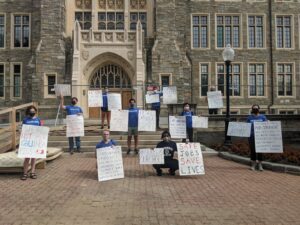Georgetown University received a $10 million gift from the Leonsis family to the Medstar Georgetown Hospital and the MSB in September. This donation, which is evenly split between Medstar’s Verstandig Pavilion and the MSB’s Entrepreneurship and the Leonsis Venture Lab, was received by Georgetown with fanfare, including an email blast to the entire community.
Georgetown has a smaller endowment compared to peer elite schools. Georgetown’s endowment is only 3.2 billion dollars compared to Harvard’s 50.9 billion dollars.
Philanthropy at Georgetown is managed by the Office of Advancement. It is led by R. Bartley Moore (F’87), Vice President of Advancement, who manages Georgetown’s relations with donors and external partners. He is working to remedy this gap.
“In the most recent 8 years, we’ve had compounded annual growth of 12%, year-over-year, in philanthropy,” Moore said in a statement.
Georgetown’s current philanthropic campaign is Called to Be and asks supporters to contribute “in service to the common good“ of the school. The main goals of this campaign include funding for scholarships and the Community Scholars Program, Counseling and Psychiatric Services, Residential Ministry, Associate Professorships, and study abroad programs, in addition to grants for the Earth Commons Institute. The campaign also encourages donors to direct their gifts to projects that Georgetown deems a priority.
“Upwards of 90% of the gifts we receive are restricted (by donors) or otherwise specifically designated for a particular purpose,” Moore said. They may be earmarked for a specific school, building, department, or even research grant.
Moore said that while many donors direct their funds to programs and grants, support for new buildings, such as a new academic law building, is critical.
“Donors often describe their interests in giving in terms of wanting to support ‘people over bricks and mortar,’” Moore said. “But, of course, great people with great ambition need facilities. Georgetown is committed to substantial investment in our built environment, both on the Hilltop and on the Capitol Campus.”
Georgetown has made a substantial investment in the downtown Capitol Campus in recent years, which houses the Georgetown Law School, the McCourt School of Public Policy, the Earth Commons Institute, the School of Continuing Studies, and the Capitol Applied Learning Labs.
Many university gifts come from large foundations such as the Andrew Mellon Foundation, Ford Foundation, Gates Foundation, and Carnegie Corporation.
These gifts come in many forms including cash, stocks, bonds, securities or in-kind gifts such as rare books or art. According to Moore, at Georgetown, stocks, bonds, and securities are usually sold and liquidated to usable cash forms. These gifts are either expendable, meaning they can be used immediately or saved in the endowment.
“Our highest ongoing priority is our commitment to scholarship and ensuring that we meet the full financial need of all eligible, admitted undergraduate students,” Moore said.
Georgetown is one of 115 need-blind colleges in the US and also meets 100 percent of demonstrated student need through a combination of scholarships and loans as well as federal work-study programs.
“Donor support for affordable access has grown dramatically in the last 15 years. During our last campaign– For Generations to Come, which ran from 2009 to 2016–we raised almost $450 million for undergraduate financial aid and graduate student scholarships,” Moore said.
Georgetown’s Office of Advancement states on their website that students who receive donor funded 1789 scholarships as part of their financial aid packages have a 15 percent higher yield compared to the general population of students who receive financial aid.
“It is one thing to be able to reasonably afford the cost to attend, but there are other elements of the total Georgetown experience not included in that cost–for example, the ability to participate in an unpaid summer internship. We have donor-supported projects underway now where we provide summer relief for students,” Moore said.
Despite these efforts, the average student receiving financial aid still graduates with 19,000 dollars in student debt, which contributes to economic segregation at the school. The median income of Georgetown families is 229,100 dollars a year. 74 percent of GU students hail from the top 20 percent of incomes in the US. Only 11 percent of GU students move up two or more income quintiles after their time at the school.
Students are the most affected by university philanthropy and therefore have a part in managing it. Moore emphasizes that students play a large role in gaining and using philanthropic funds at Georgetown, from using financial aid to directing funds for various projects.
“Students are involved in virtually every aspect of fundraising. This includes the student workers who staff our nightly phone banks, as well as members of The 1634 Society, a student-run organization dedicated to celebrating Georgetown’s traditions,” Moore said.
Editor’s Note: This story has been corrected to clarify that Georgetown Giving is not a separate university program, but the website from where the Office of Advancement publicizes their giving campaigns. The story has also been updated to correct a quote: Georgetown’s Called to Be campaign asks supporters to contribute “in service to the common good,” not “contribute to the common good.”





